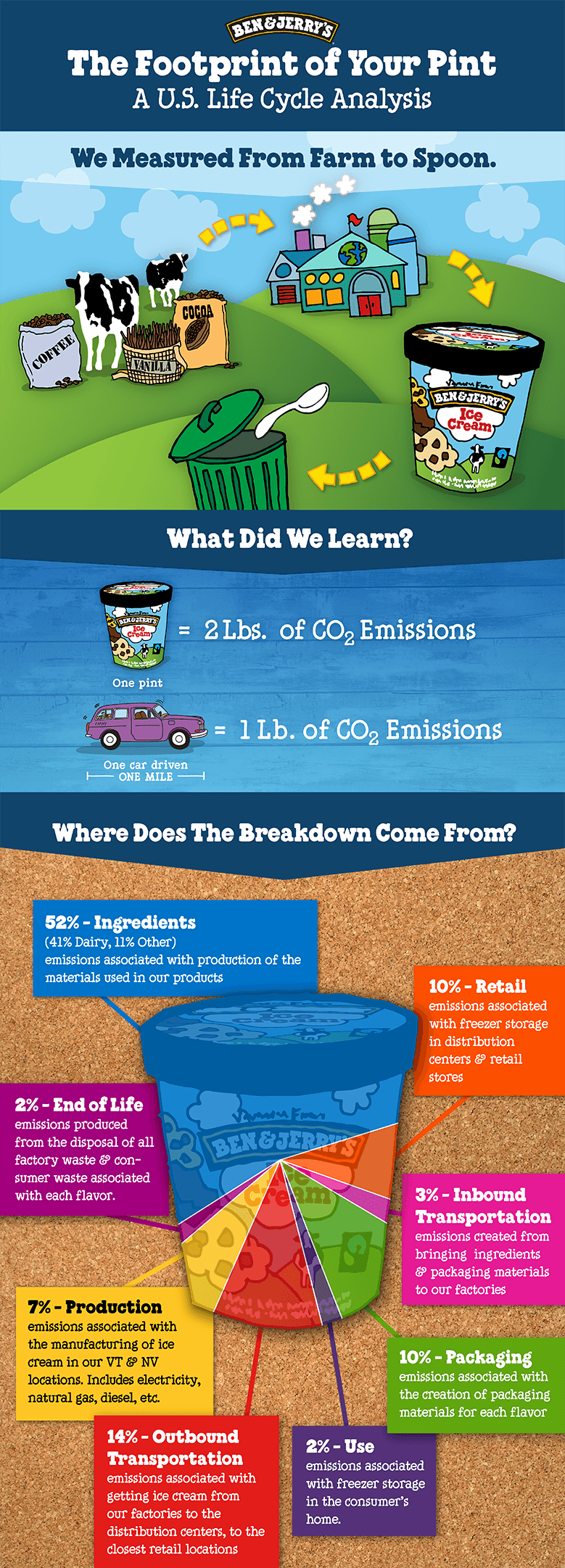At Ben & Jerry’s, we’ve been working for a long time to reduce our environmental impacts, including our greenhouse gas emissions. With the challenge of climate change looming larger than ever, we wanted to take stock of our largest emission sources, and develop concrete strategies on how to drive them even lower. We wanted to measure what matters, so we turned to a small start up company called CoClear for a life cycle analysis (LCA) study of our products.
What is an “LCA” you ask? Basically, you take a product— in this case, twenty flavors of ice cream— and using sophisticated databases and math equations, trace the carbon emissions that all the ingredients, manufacturing, transportation, even retail, contribute. What we learned is that each pint we make adds up to two pounds of CO2 emissions to the atmosphere. To give you an idea of how much that is, a medium car generates around one pound of CO2 per mile driven.

“We did this because we really need to understand our largest source of greenhouse gas emissions,” says Andrea Asch, Ben & Jerry’s Manager of Natural Resources. “If we’re going to engage the public about reducing their own carbon footprint, then we need to understand what our own footprint is and come up with strategies for reductions.”
CoClear’s study allows an in-depth picture of the emissions of each stage of our ice cream’s “life cycle.” Let’s look at where the greatest climate impact lies:
- Growing and producing ingredients: 54%
- Transporting ice cream from our plant to the distribution centers: 14%
- Freezing product at the stores: 10%
- All packaging throughout the production process: 10%
- Operating our factories : 7%
This information lets us evaluate production scenarios that maximize efficiency for each flavor— for example, manufacturing Chocolate Chip Cookie Dough ice cream at the plant nearest to where the actual cookie dough is created could cut down transportation costs and emissions. Meanwhile, our manufacturing plants have already done a tremendous amount of work to reduce their emissions— work that’s contributed to our factories counting for only 7% of our total emissions. Ben & Jerry’s success with pursuing the EPA to approve the use of hydrocarbon refrigeration in the US should soon reduce the impact of freezing ice cream at convenience stores.
“I think if you ask people where is the carbon footprint in a pint of ice cream, I think they would start talking about refrigeration and trucking,” says Chris Miller, Ben and Jerry’s Social Mission Activation Manager.
Surprising then, that the LCA showed that 41% of Ben & Jerry’s total carbon footprint is traceable back to the cows that create the common ingredient in every Ben & Jerry’s flavor— cream. When it comes to climate change, the methane from the front and back ends of cows is approximately 21 times more potent than C02, making manure management a major opportunity for improvement. The nitrous oxide associated with fertilizers doesn’t appear in the same quantities as methane, but clocking in at 300 times more potent than CO2, this gas is another area where we need to help farmers reduce their use.
“We knew that dairy was significant,” says Asch. “Now that we have a number, we can set targets and work towards reducing this source of GHG emissions with creative solutions. It’s probably going to include technologies that enhance the value and use of manure on the farm, as well as some new approaches on the farm.”
Already, Ben & Jerry’s is working with farmers on innovations like a separator that makes bedding out of manure, reducing 50% of the methane that would otherwise end up in the lagoon. It’s a win-win, saving the farm that is using the technology $30,000 in bedding and manure management costs annually, and reducing greenhouse gas emissions 10,000 metric tons over 10 years.
The details of an LCA can be a bit messy. But at Ben & Jerry’s, we’ve always held fast that businesses have the responsibility to disclose their social and environmental efforts, as well as their shortcomings. “By showing the world where your impact is,” says Miller, “it obligates you to do something.”
What’s next? Asch reports that the Caring Dairy initiative will start measuring greenhouse gas emissions on farms starting in 2016. Soon Ben & Jerry’s will be sharing their global climate goals for 2020 and 2050. Next winter, leaders from around the world will meet in Paris to discuss and hopefully agree on a global plan to get climate change under control by enacting broad limits on carbon emissions. As a company, we’re proud to share the results of the 2014 LCA, the road map toward reducing our own impact, pint for pint.